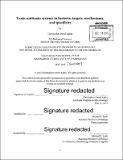Toxin-antitoxin systems in bacteria : targets, mechanisms, and specificity
Author(s)
Aakre, Christopher David
DownloadFull printable version (15.72Mb)
Alternative title
Toxin-antitoxin systems in bacteria : mechanisms, targets and specificity
Other Contributors
Massachusetts Institute of Technology. Department of Biology.
Advisor
Michael T. Laub.
Terms of use
Metadata
Show full item recordAbstract
Toxin-antitoxin (TA) systems are genetic modules widely present on bacterial chromosomes. These systems comprise a toxin and cognate antitoxin that are encoded together in an operon; normally, the toxin and antitoxin are synthesized and form a non-toxic complex. Under times of stress, however, the more labile antitoxin can be degraded, which frees the toxin to inhibit growth. TA systems have been implicated in a number of important processes, including plasmid stability, phage resistance, persistence, and virulence. Yet, there are a number of unanswered questions about these genetic modules. What are the cellular targets of toxins? How do antitoxins antagonize their cognate toxins? Do toxins and antitoxins interact in a one-to-one manner - one antitoxin for one toxin - or do they form large networks of cross-reacting systems? To answer these questions, I have studied the targets, mechanisms, and specificity of TA systems in bacteria. For my first project, I identified SocAB, a novel TA system in the bacterium Caulobacter crescentus. Unlike canonical TA systems, in which the antitoxin is less stable than the toxin, I found that the toxin SocB is unstable and constitutively degraded by the protease ClpXP. This degradation requires its antitoxin, SocA, which acts a proteolytic adaptor. Furthermore, I found that SocB blocks replication progress through an interaction with the sliding clamp, thus expanding the number of known cellular targets for TA systems. For my second project, I studied interaction specificity in the ParDE TA family. I found that toxins and antitoxins in this family exhibit a strong preference for interacting with their cognate pair, and that specificity is determined by a small subset of coevolving residues at the interface of these two proteins. To understand how the identity of these coevolving residues controls interaction specificity, I generated a library of ~10⁴ variants at these coevolving positions in the ParD antitoxin. By reacting this library against both cognate and non-cognate ParE toxins, I identified promiscuous ParD variants that are densely connected to specific variants in sequence space. These promiscuous states may facilitate changes in TA specificity and promote the expansion of these paralogous systems by duplication and divergence.
Description
Thesis: Ph. D., Massachusetts Institute of Technology, Department of Biology, 2015. Title as it appears in MIT Commencement Exercises program, June, 2015: Toxin-antitoxin systems in bacteria : targets, mechanisms, and specificity. Cataloged from PDF version of thesis. Includes bibliographical references.
Date issued
2015Department
Massachusetts Institute of Technology. Department of BiologyPublisher
Massachusetts Institute of Technology
Keywords
Biology.